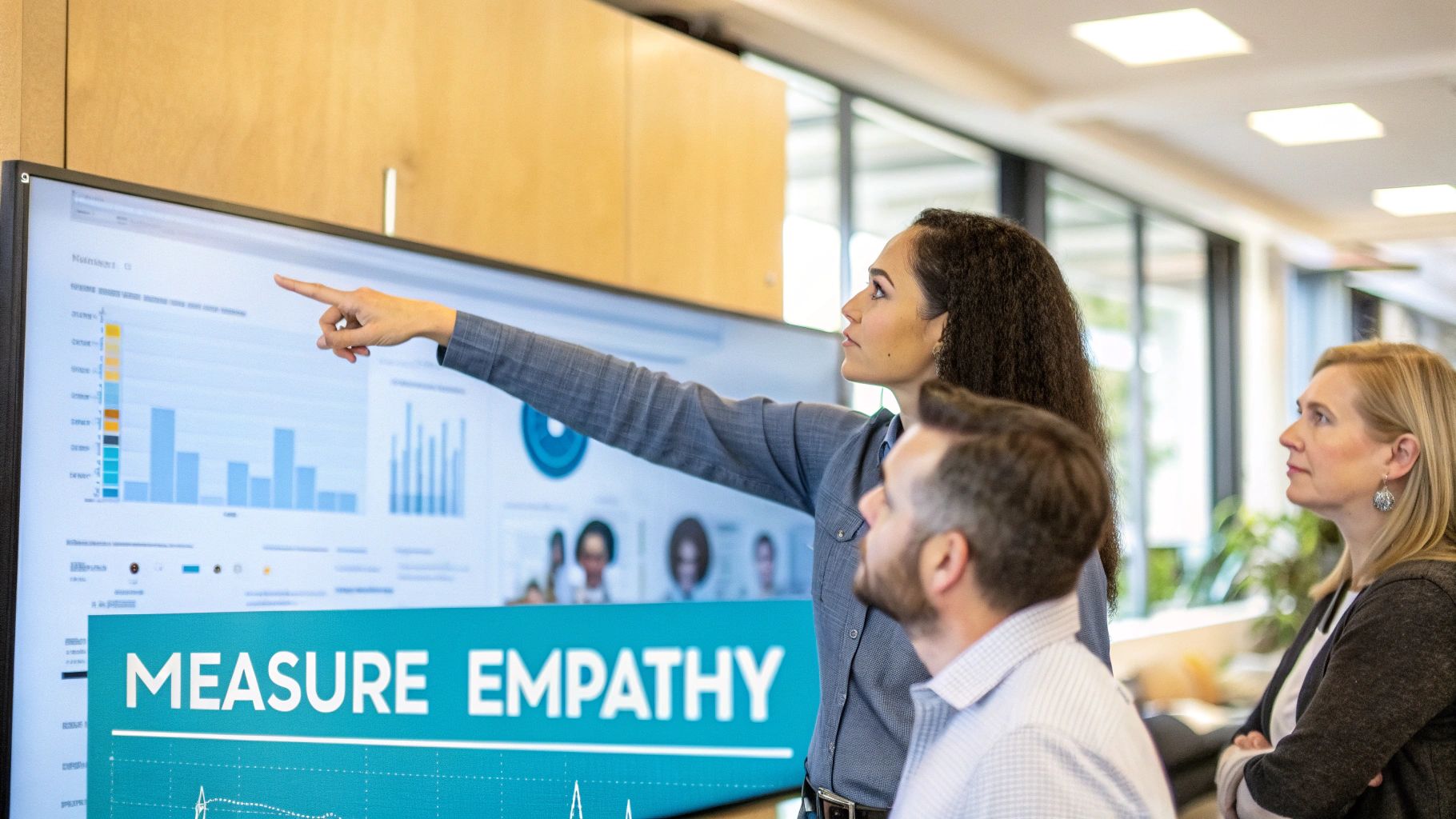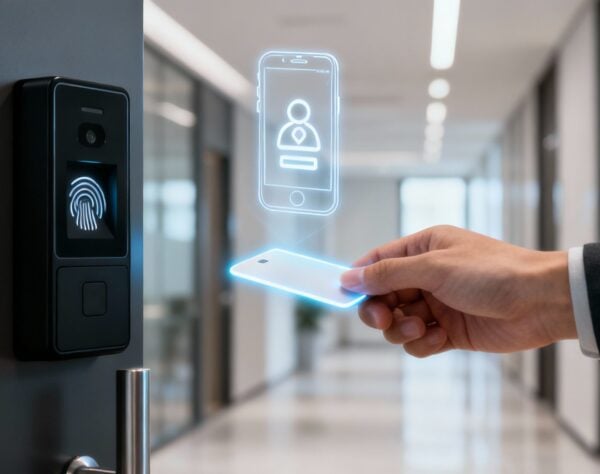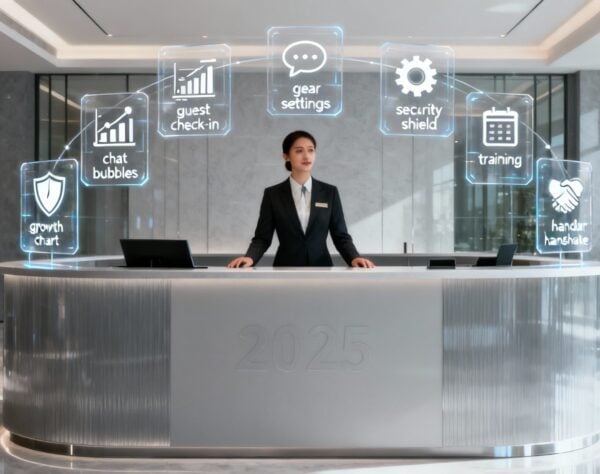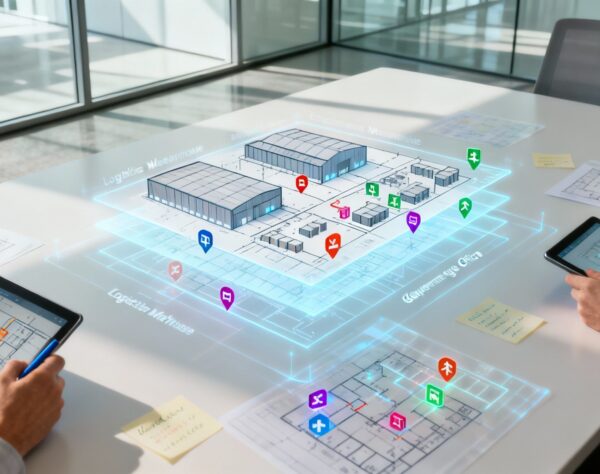
Mastering Customer Service and Empathy
Empathy in customer service isn't just a soft skill—it's a critical driver of business success that directly impacts your bottom line. Ignoring it is a massive risk to customer loyalty, brand reputation, and ultimately, revenue. In today's competitive landscape, empathy is a strategic necessity.
The High Price of Poor Customer Experiences
Customers today have endless choices and sky-high expectations. A single poor interaction is often enough to send them to a competitor. Unempathetic service isn't a hypothetical risk; it's a measurable problem that stunts growth. This isn't just about one lost sale—it's about losing the entire lifetime value of a customer and facing the negative word-of-mouth that follows.
The Numbers Don't Lie
Hard data paints a stark picture of why empathy is essential for survival.
As customer expectations climb, 93% of customer service teams report feeling increased pressure. Yet, a significant gap remains, as 80% of consumers still report bad service experiences. This disconnect has serious consequences: 73% of consumers will switch to a competitor after multiple bad interactions, directly linking service quality to customer retention.
This trend is especially strong among younger generations. Gen Z, for example, values empathetic communication more than almost any other aspect of customer support. This shift forces businesses to rethink how they connect with their audience.
The modern business reality is clear: 79% of companies now see customer experience as a revenue driver, not a cost center. This proves that investing in empathetic, personalized engagement is a direct investment in profitability and long-term success.
A lack of empathy doesn't just damage customer relationships; it creates internal risks. A high-stress environment fueled by customer frustration often leads to employee burnout. This can even affect on-site safety and preparedness. To keep both your team and visitors safe, it's always a good idea to review and strengthen your emergency evacuation procedures in the workplace.
What Empathetic Customer Service Actually Looks Like
Genuine empathy in customer service is more than just being polite. It's about anticipating needs and guiding customers to a solution with confidence and care. This approach begins the moment a customer or visitor interacts with your business.
A great first impression sets the right tone. For example, a modern visitor management system creates a smooth, stress-free arrival, which is a powerful, silent act of empathy. It shows visitors you value their time and experience from the start, allowing your team to focus on a warm, human welcome rather than administrative tasks.
The Three Layers of Empathy in Action
To truly master empathy, it helps to understand its three distinct layers. Each one builds on the last, moving from simple understanding to a genuine drive to help.
- Cognitive Empathy: The foundational "I get it" moment. You logically understand the customer's problem, grasp their perspective, and know what they need to achieve.
- Emotional Empathy: This layer goes deeper, from "I get it" to "I feel for you." You connect with the customer's frustration, disappointment, or urgency, acknowledging the human emotion behind the issue.
- Compassionate Empathy: This is where understanding and emotion turn into action. You combine cognitive and emotional empathy to become the customer's advocate, driven to find a solution.
This framework shows how empathy directly ties into critical business outcomes, from customer satisfaction to reducing churn, as the infographic below illustrates.
Improving these numbers is the direct result of making customers feel genuinely heard, understood, and supported.
Why Feeling Valued Matters More Than Ever
Empathy is a massive driver of consumer choice. In fact, around 70% of buying experiences are based on how customers feel they are being treated. When your team can de-escalate a tense situation by acknowledging a customer's feelings, they can turn a negative moment into a loyalty-building opportunity.
An empathetic approach makes customers feel valued as people, not just transaction numbers. This emotional connection is the bedrock of lasting brand loyalty and powerful word-of-mouth advocacy.
Of course, making this happen requires a solid strategy. For a deeper dive, check out these 10 best practices for customer service. And since the first interaction is crucial, our visitor management checklist can help ensure every guest's journey starts perfectly.
The Undeniable Business Benefits of an Empathy-First Approach
Adopting an empathy-first approach is a powerful strategy that delivers tangible business growth. Connecting with your audience on a human level translates directly into measurable gains in revenue, loyalty, and brand health. This shift from a transactional to a relational mindset is proven by the numbers.

When customers feel understood, they don't just buy once; they return. This focus on customer service and empathy builds a foundation for higher lifetime value and turns satisfied buyers into vocal advocates.
Driving Revenue and Customer Loyalty
The financial impact of empathy is undeniable. Companies that prioritize emotional connection see direct bottom-line improvements because empathy builds trust. A customer who feels heard is far more likely to remain loyal, even if a competitor offers a lower price. This loyalty creates a powerful ripple effect, as happy customers drive word-of-mouth referrals that lower acquisition costs.
Empathy isn't an expense; it's a revenue generator. When customers feel valued, they are more forgiving of mistakes, more open to new products, and more likely to recommend your business to others.
Investing in a seamless, welcoming experience from the first interaction sets the stage for this relationship. A visitor management system delivers this benefit by showing you respect a visitor's time and safety. This frees up your team to provide a personal, human welcome instead of getting bogged down by administrative tasks.
Impact of Empathy on Key Business Metrics
This table quantifies the benefits of implementing an empathy-led customer service strategy, connecting specific actions to tangible business results.
| Business Metric | Impact of High Empathy | Supporting Statistic or Benefit |
|---|---|---|
| Customer Loyalty | Increased repeat business and reduced churn. | Customers are 3x more likely to repurchase from an empathetic brand. |
| Revenue Growth | Higher average order value and lifetime value. | Empathetic companies can increase revenue by 5-10% in 2-3 years. |
| Brand Reputation | Positive word-of-mouth and stronger brand image. | 76% of consumers are more loyal to companies that show they understand their needs. |
| Customer Acquisition | Lower acquisition costs through organic referrals. | Referred customers have a 16% higher lifetime value. |
The data is clear: empathy is a hard asset that contributes directly to a healthier bottom line.
Boosting Employee Morale and Resilience
The benefits of an empathy-first culture extend beyond customers to create a healthier internal environment. When employees are empowered to genuinely help customers, job satisfaction soars.
This positive atmosphere leads to several key internal advantages:
- Reduced Agent Burnout: Empowered employees who can solve problems without rigid scripts feel more fulfilled and less stressed.
- Lower Employee Turnover: A supportive, empathetic workplace culture is a major factor in retaining top talent.
- Improved Team Cohesion: When empathy is a core value, it fosters better collaboration and mutual respect among colleagues.
A team that feels valued is better equipped to make your customers feel valued, creating a self-reinforcing cycle of positivity that drives sustainable success.
Practical Ways to Cultivate Empathy in Your Team
Empathy isn't an innate trait; it's a skill that can be developed. Like a muscle, it strengthens with the right training and a supportive environment. The goal is to move beyond simply telling staff to "be more empathetic" and equip them with practical tools for real-world interactions.

From Scripts to Authentic Connection
Rigid scripts are one of the biggest killers of empathy. While they ensure consistency, they can prevent an agent from truly listening. When employees feel like robots, customer satisfaction often declines. Empowering your team to solve problems without a script builds trust and gives them the freedom to be human.
True empathy flourishes when agents are free to be present in the conversation, not just reciting lines. The focus moves from "What am I supposed to say next?" to "What does this person actually need from me right now?"
This freedom allows for active listening—the foundation of any empathetic exchange.
Structured Training for Real-World Scenarios
Building this skill requires ongoing effort, not a one-off seminar. Here are a few practical training methods that work.
- Active Listening Frameworks: Teach teams to repeat a customer's issue back to them ("So, if I'm understanding correctly, the delivery never arrived?"). This confirms understanding and shows the customer they are being heard.
- Scenario-Based Training: Role-playing is incredibly valuable. Practice difficult conversations—like handling frustrated or confused customers—in a safe, controlled setting.
- Interpreting Digital Tone: Since so much of customer service is text-based, train your team to spot emotional cues in emails and chats. Short sentences, ALL CAPS, or a sudden change in tone can reveal how a customer is feeling.
Creating Space for Empathy with Smart Tools
Technology can be a powerful ally in fostering human connection. By automating the right tasks, you free up your team's mental energy to focus on the customer.
A visitor management system is a perfect example. It handles the administrative grind of check-in—like ID verification and host notifications—which is a major benefit. This allows your front-desk team to greet visitors with their full attention, make eye contact, and offer a genuinely warm welcome. For instance, you can easily learn how to enable guided access on an iPad to create a dedicated check-in kiosk. This approach demonstrates that you value both efficiency and the human touch.
Leveraging Technology to Enhance Human Empathy
It's a common myth that technology is the enemy of human connection. When used correctly, technology can be empathy’s greatest ally. Smart tools excel at handling repetitive tasks, freeing up your team to apply their emotional intelligence where it counts most. This partnership empowers your people to handle complex situations that demand a real human touch, reframing technology as a bridge to more empathetic service.
Moving Beyond Basic Automation
The real value of technology isn't just about speed; it's about creating space for deeper human connections. A visitor management system delivers this benefit by automating the check-in process. This lifts the administrative burden from your front-desk staff, freeing them to offer a warm greeting and provide personal assistance. They can focus on making a visitor feel welcome instead of fumbling with a clipboard. To see how this works, discover how to enable SMS notifications for visitor arrivals to keep your team informed and ready.
A major shift in this area is the rise of Customer Empathy Management (CEM) platforms. These tools quantify emotional responses, which is a major competitive advantage since 90% of customer decisions are driven by emotion. With up to 90% of feedback being unstructured, understanding how customers feel is critical. Read the full research on these emerging customer experience trends to see why this is becoming so important.
Using Data to Foster Understanding
Technology also provides invaluable insights for building a more empathetic culture. By analyzing interaction data, businesses can spot common pain points and proactively address them.
Technology’s role isn’t to fake empathy, but to create an environment where genuine human empathy can thrive. It clears away the noise so your team can focus on listening, understanding, and connecting.
This data-driven approach allows you to understand customer feelings at scale. You can identify friction points, celebrate successes, and train your team to handle specific emotional scenarios more effectively. Ultimately, technology gives your people the context and freedom they need to provide truly exceptional customer service and empathy.
Got Questions About Customer Empathy? We've Got Answers.
Let's dig into some of the most common questions businesses have when focusing on a more empathetic culture. The goal is to provide clear, straightforward answers that connect customer understanding to real business growth.

How Can We Measure the ROI of Empathy Training?
Measuring the ROI of empathy training isn't as abstract as it sounds. It comes down to tracking key metrics before and after you implement new initiatives. Monitor customer-facing numbers like your Net Promoter Score (NPS), customer retention rates, and Customer Satisfaction (CSAT) scores. Also, track internal metrics like First Contact Resolution (FCR) and employee turnover. A measurable lift in customer loyalty combined with a drop in agent churn demonstrates a clear financial return.
Can We Be Empathetic and Efficient at the Same Time?
Absolutely. In fact, true empathy often leads to greater efficiency. An empathetic agent builds trust, which encourages a frustrated customer to share the root of their problem more quickly. This trust cuts through the noise, reduces back-and-forth communication, and leads to faster resolutions.
This is where technology provides a major benefit. A modern visitor management system, for example, automates the check-in process, making it incredibly efficient while still feeling personal and welcoming. It's a prime example of being both highly effective and deeply empathetic.
What Is the Biggest Mistake in Building Empathy?
The single biggest mistake is trying to script empathy. Handing agents a list of phrases like, "I understand your frustration," comes across as hollow and insincere, which can make a tense situation worse. Customers can spot a fake apology from a mile away.
True empathy isn't a script; it's a culture. It's about hiring naturally empathetic people, providing ongoing emotional intelligence training, and empowering them to solve problems without being constrained by rigid policies.
This is how customer service and empathy becomes a core part of your operations, not just a checkbox.
How Does a System Like VisitUs Improve Empathy?
A system like VisitUs delivers a key benefit by showing empathy from the moment a visitor arrives. Instead of a messy, impersonal sign-in sheet, you offer a smooth, modern, and respectful welcome that immediately shows you value their time and safety.
The real magic is the benefit it provides to your team. By handling tedious administrative tasks, the system frees up your front-desk staff to focus on what matters: making eye contact, offering a warm greeting, and providing genuine, personal help. This sets a positive, empathetic tone for the entire visit.
An empathetic first impression creates lasting loyalty. VisitUs provides a seamless, secure, and welcoming check-in experience that empowers your team to focus on human connection. Learn how VisitUs can transform your front desk.





